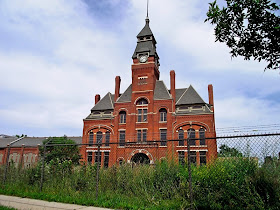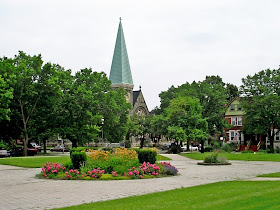 |
| Mural underneath the train tracks at 113th St. & Front Ave. |
The boundaries: The Pullman community area is bounded by 95th Street to the north, 115th Street to the south, and Cottage Grove Avenue to the west. To the northeast it’s bounded by Stony Island Avenue, and to the southeast the Bishop Ford Freeway (I-94). The majority of the historic district (or at least the accessible portion) lies just east of Cottage Grove Avenue between 111th Street and 113th Street although when it was first built it went much further north and south.
Population make-up: Pullman is made up of Census tracts 5001, 5002, and 5003. Pullman is Chicago’s fifth smallest of the 77 community areas by population. This is largely due to the industrial presence within its boundaries, but also to a population decrease in the past ten years. The number of residents has dropped from 8,921 in 2000 to 7,325 in 2010, a 17.9% decrease. The historic district itself is home to ~1500 people. As of 2010, the ethnic make-up of Pullman was 83.8% black, 7.9% Hispanic, and 7.4% white.
 |
| Remnants of the Pullman factory, severely damaged by fire in the late 90s. |
In Pullman, his employees could live within a ten minute walk from the factory. He built a town hall, hotel for guests, public parks, homes of various sizes, a predecessor to today’s shopping malls, and a church that could be rented/used by any Christian denomination. Workers didn’t own their homes, but rented. Their benefits included indoor plumbing in every home, something unheard of in the 1880s. Unfortunately, the Pullman Railcar Company hit hard times in the mid-1890s. Wages were slashed, yet rents remained the same. This resulted in one of U.S. history’s most famous union strikes. Within 15 years, Mr. Pullman passed away, the Illinois Supreme Court demanded that the company withdraw ownership of the residential properties, and the town became annexed as part of the City of Chicago.
 |
| The beautifully restored Administration Building. |
Getting there: If you’re counting on the “L”, your only bet would be the Red Line to its terminus at 95th/Dan Ryan and then taking the Pullman bus (111). However, you can definitely take the Metra as well. The Metra Electric District line (from Millenium Station) makes stops along the western border of Pullman at 95th, 103rd, 107th, 111th, and 115th. The stop at 111th Street will drop you right off at the historic district.
By bus your east-west options are: 95th Street/Jeffery Manor Express (100), 103rd Street (106), and Pullman/111th/115th (111). Bus route 111 is also your only north-south option, as it covers Cottage Grove Avenue as well.
Cal-Harbor Restaurant & Lounge (546 E. 115th Street)
A glorified diner, and no, this is not an insult. The menu is long, the service is pleasant, and the crowd is a microcosm of the diversity within the entire City of Chicago. Straddling the line between Pullman and Riverdale (with both Roseland and West Pullman only a couple blocks west), one of Pullman’s few spots for sit-down dining is worth a peek beyond its humble exterior.
 |
| You can't miss that yellow awning. |
Laura’s Take: A different story altogether from what we’re used to up on the north side. Although I didn’t feel comfortable taking an interior picture, the setup inside is kind of unique. The guys making your food are arranged in the center of the diner with flat tops and counter space as the focal point in front of the stools. There are some booths situated around the perimeter as well, but the kitchen is really out in the open. The staff is an eclectic mix, one of whom was the nice lady who served us, calling almost everybody “honey”. Food was solid with some extra choices you might not expect at this type of diner, like the turkey pita meal that I ordered. Unexpectedly, they seared the turkey on the flat top! Other than that they offer the enormous menu that is often seen at places like this: burgers, sandwiches, soups, full meals, etc. No frills, by any means. If you don’t like the idea of eating food that was made bare-handed, just order the soup. At least they’re not hiding anything behind the kitchen doors! The chicken rice soup really reminded me of my grandma’s chicken and biscuits – it was crazy.
Anything Else We Missed: Cal-Harbor looks small up-front (forgive the lack of interior pictures). However, it goes further back where you have access to a full bar. Parking on 115th Street is not a problem either.
Tour of Historic Pullman (11141 S. Cottage Grove Avenue)
 |
| Greenstone Church |
There’s a small museum inside the Visitor Center that plays a couple videos, and that will give the uninitiated a lot of valuable background. Some historical pieces from the town are also on display. But it’s actually walking through the historic town that’s truly satisfying.
 |
| Historic rowhouses on Champlain Avenue |
An interesting standout is the 12 apartments, separated into quadrants of three units each, surrounding the market square. The quadrants, if connected, would form a circle instead of a square, and therefore the sections are actually bow-shaped, as opposed to being linear or even L-shaped. Pillars front the first floor of these apartments, creating a unique walkway fronting each unit. The market square itself has been in disrepair for decades. Our tour guide noted that although a $1 million grant has been secured to help in restoration, $2 million more is needed to finish it. With a down economy, it’s unlikely that we’ll see it completed any time soon. Hopefully, down the road, the work of preservations will help restore this public space back to its original state.
 |
| Curved apartments surrounding Market Square |
Admittedly, a tour of a planned community from over 100 years ago just isn’t for everyone. But anyone with an interest in architecture or Chicago history will find the tour rewarding. Our walking tour guide was a lifelong Pullman resident as was our guide for the inside of the Hotel Florence. Their passion for Pullman is unmistakable, as is that of the residents who inhabit its streets. Their efforts have salvaged a remarkable piece of American history, and their gift to Chicago is a terrific historical and architectural destination.
Anything Else We Missed: The one truly unfortunate thing about the tour is that the Administration Building is still closed off to the public. However, there is a large sign on 111th Street that shows the unfortunate aftermath of the 1998 fire (only the building’s skeleton remained). To compare this photo with the state of the Administration Building today is simply awe-inspiring. Here’s to hoping that a re-opening of this Pullman icon to the public will be just the next step in the restoration of a truly remarkable area.
Pullman: The Final Tally
 |
| Arcade Park in the heart of Historic Pullman. |
For perspective on any perceived crime in this area, the violent crime rate from July 2010-June 2011 in Pullman was less than half the per capita rate of the Near North Side, a community area that is made up of neighborhoods such as Streeterville, River North, and the Gold Coast. There have been recent reports of crime in Pullman, but this is often misleading as the neighborhoods of West Pullman and Roseland often get lumped into the moniker “Greater Pullman”, and aren’t representative of the Pullman community area’s actual boundaries. Yes, for those accustomed to condominium high-rises, the site of old factories and quiet streets may be intimidating. Rest assured that the residents we encountered either warmly welcomed us to the neighborhood or simply minded their own business.
Pullman is worth seeing, even if just once. Even though public transit isn’t an easy option, those with access to a car should definitely make the effort and help support the area’s renovation efforts. It is an outstanding slice of both Chicago and U.S. history.
 |
| Map of our Pullman destinations. |
 |
| Pullman workers mural painted on the north side of the Visitor Center. |
 |
| Well-manicured front lawns line the neighborhood streets. |
 |
| Refurbished dining room inside the Hotel Florence. |
 |
| Pullman (purple) is very accessible by highway. The Loop is shown in blue. |

gümüşhane
ReplyDeletebilecik
erzincan
nevşehir
niğde
SN0KFO